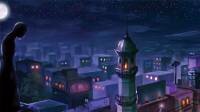Bounding from roof to roof, our heroine stealthily cuts across a village skyline, making aerial high dives and pirouetted twists, in an animated promo, as she defends her little hamlet, Hawalpur from evil and its agents.
Armed not with weapons, gadgets or a snazzy car, this heroine is out to make a difference, using, quite literally, the might of the pen and the book to dash the plots and schemes of her Jafar-esque nemesis, Baba Bandook.
In the tradition of comic book heroes, this fearsome lady lives a double life, being an unassuming teacher by day and crime fighter by night but unlike her scantily clad, sheer and indeed physics-defying-wardrobe counterparts that so dominate the heroine pantheon, this lady in black is all modesty, covered head to toe in a Burka.
Much vilified in the world, the burka has come to enjoy the kind of reputation that sends FEMEN activists into a bare breasted frenzy, the French government into official strictures and then, more closer to home, incensing the more priggish at its absence while prompting others to ask if it comes in blue.
There is a certain symbolism, a certain iconicism, and a certain duality in the burka, where some see Neolithic cultural baggage, others, hallowed modesty but as a pop culture image, say like the Sombrero (Speedy Gonzalez), the Kimono (any number of Manga characters) or even Jodhpur pants (the Indian Spiderman), the burka remains stereotypically fixed.
In the comic book series, the Uncanny X-Men, the Afghan Muslim character, Dust, ‘marvels’ all with her mutant powers but does so from behind a veil, incongruously speaking Arabic rather than Pashto.
In the 99, the Muslim superhero group, several female characters wear either a veil or a headscarf. In either instance, there is say, an overt pronouncement of the burka and its underpinnings, the former possibly being a bit of a jab (how fitting that the Muslim character’s powers allow her to control and become sand and dust) while the latter plays it safe, treading lightly lest anathema is pronounced.
Of course, if the burka has been used to such varying effect this does beg the question, what about our Lady in Black, the Burka Avenger? Does her garb say something?
Ninja-like in her appearance (pun very much intended), the Burka Avenger uses her burka as the perfect disguise, concealing her true identity from the bad guys with an air of mystery to boot. The Lady in Black or Jiya as she is known in mufti comes with the perfect back story; being orphaned as a child she is raised by a Kabaddhi master, Kabaddhi Jan who teaches her the secret art of Takht Kabaddhi, which she puts to particular effect dispatching the baddies and their plotting schemes.
In a context like our own, the Burka Avenger, or at least her costume comes to be particularly apt, for with all the emotion that is fomented at the sight of women in the media, it’s hard to imagine how the burka could possibly get a rise out of anyone.
As one of the first animated superhero series of our own, the Burka Avenger is a novelty in many regards, even more so because of its provenance.
As one half of the pop duo Awaaz, Haroon Rashid made his name as a pop singer in the 90s, going on to have a successful solo career in the 2000s. Along the way it seems, the idea for the Burka Avenger germinated somewhere but as Haroon recounts, it didn’t start off as an animated series at all but a reaction to the onset of the smartphone.
“Everyone was really into playing games on their smartphones a couple of years ago, and I really wanted to develop a game for the platform. Burka Avenger was just one of the ideas I had in mind at the time and I thought I’d run with it, developing it with a local game house.”
Of course, video games these days aren’t your cut and dry Pong or Space Invader but are infinitely more detailed, offering storylines, plots, character development and so on, and in putting together the game for Burka Avenger, Haroon and his team built up quite a legend around the character, enough for the team to think, why not develop this into an animated series?
Pakistan’s track record with animation has been sketchy at best. While generations were raised to STN’s morning broadcasts of Thunder Cats, Teenage Mutant Ninja Turtles and the like, indigenous content barely existed.
A lone voice in this regard was Nigar Nazar of Gogi fame which made regular appearances as a comic strip and even found its way into ‘public edification’ but as a true animated series; the adventures of the Lifebuoy or Dettol gang don’t count, we haven’t even had a first.
Going from a smartphone game to an animated series was, according to Haroon, a tortuous process as this entailed pooling the necessary talent for something that hadn’t really been done before. Animations houses per se did not exist in the country and advice often given suggested outsourcing the project.
But for the Burka Avenger, Haroon wanted to keep the production as local as possible and this meant starting from scratch, assembling a team of animators, story board artists, voice talent etc to do show. Over the course of some eight months, Haroon’s animation studio in Islamabad put together the first season of the Burka Avenger, which as half an hour broadcasts is expected to go up on air imminently.
Sure enough, while the show does set precedent for animation in the country, there was a more overt motive behind such a venture, something that is meant to “enlighten and reinforce positive social behaviour” as Haroon explains, “ You know I wanted to do something that had a message but not in a typical cliché way. Jiya/the Burka Avenger is a teacher but she’s also a superhero, she means something to the children of her village, she influences them. That’s why I didn’t want her to use violence or anything, she uses books and pens instead, throwing them at the bad guys.....it’s about what education can do, what a woman can do and how children can learn from that.”
Pitted against the Burka Avenger are a proper rogues gallery of misfits, starting with the jalli jadooghar, Baba Bandook and his henchmen, who along with the crooked local mayor, Vadero Pajero (aren’t they all) are dead set on causing grief to the village and, in particular, its kids, trying to close down the local school. For the show, Haroon has thrown his celebrity weight around, calling in the likes of Ali Zafar, Ali Azmat, Laal, and QB to record the soundtrack for the show, with each edifying song appearing at the end of the episodes, like a neat ‘moral of the story’.
With children nowadays being so inured to cartoons like Ben 10 and Generator Rex, how local fare like the Burka Avenger will stand up to their sugar-high scrutiny will remain to be seen for such pernickety viewers won’t necessarily care for the ‘message’ of such a cartoon or even the fact that its protagonist wears a burka, to them, it’s how hard the Lady in Black can punch and whether or not Haroon still has his pipes.
The writer is an art critic based in Islamabad.
























